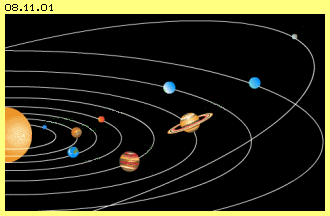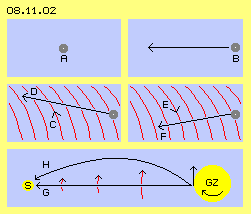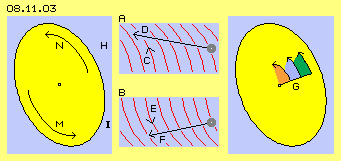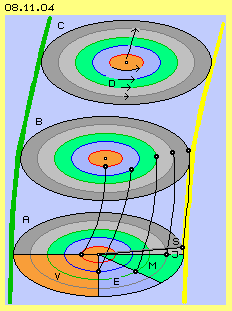Edge Appearance
Motions within Space
If that vortex shows a forward-impulse (see arrow at B), this vortex is moving straight line and by constant speed through space. Only within gapless aether this motion is possible without any ´friction-losses´ (and only under that condition constant of energy is valid and possible). That straight and constant motion however can only occur within regions of really neutral aether. Only that ´pure´ aether offers conditions which commonly are assumed for ´pure vacuum´ (which however is only a theoretic fiction). For this ideal shape of motion (of material appearances) terms of ´kinetic energy´ and ´inertia of moving bodies´ are suitable.
Normally however aether shows circling motions, practically all times with overlays and thus inevitably resulting ´tracks-with-stroke´, i.e. one time-half with relative short way and one with relative long distance. Because all neighbouring aetherpoints must behave analogue, likely aether-motions are wide-spread, e.g. like previous chapter did show by example of milky way. All atoms respective their vortex-systems become deformed, as they are pressed-back little bit and at the following are stretched some more forward into direction of that stroke.
Drift
At previous galaxy, all aether shows these strokes around centre of milky way. Celestial bodies circling around centre don´t move based on own motion-impulse but are only swimming according to that aether-motion-with-stroke, finally running all around galaxy. These celestial bodies have no tangential outward showing inertia resp. corresponding centrifugal forces - and thus must not be drawn-inward by any attracting force. If bodies are moving within space based at own impulse (like upside D and F), also their noticed speed and direction are only ´gross-data´, because all times inclusive general aether-motion (within sun system e.g. most relevant concerning comets).
Materia realiter is not moving straight line and constant speed within a vacuum. Local aether-vortices of material appearances are drifting into each direction of aether-strokes all times, within milky-way and also within sun-system. If bodies are not ´resting´ but show own forward-impulse, their way and speed all times is affected by stroke-pattern of aether they are passing. Terms of mass and impulse, of inertia and centrifugal forces, commonly are handled as if all processes would occur within vacuum. Reality of aether however is other stuff - and consequently thus observations must be interpreted other kind - and physical calculations must be changed.
Light within Space
At this picture 08.11.02 at bottom, way of light from galactic centre (GZ) towards sun-system (S) is shown. Light of a star e.g. is radiated into radial direction, however light is not running outward straight line (as marked by arrow G). That star is rotating with galactic centre and naturally that radiated ´photon´ has that impulse into tangential direction (see arrow showing upward). Light-ray thus is running diagonal off star, because star by itself is drifting within corresponding aether-motion and also afterward still likely aether-stroke exists.
Finally further outside, that stroke is reduced (lastly by Free Aether of environment around galaxy) and milky-way there is turning some slower (see red arrows). Forward-direction of light correspondingly is ´braked down´. The light from galactic centre to sun-system is moving at curved track, like schematic marked by arrow H.
When we are looking towards galactic centre, not only we see situation existing there 26000 years ago - but we also are looking into wrong direction. This light passes inner spiral arms where it naturally is bothered by turbulences of local aether-movements. Inevitably these light-vortices become ´distorted´, i.e. red-shifting of light by sure is not only based on ´Doppler-Effect´ (as already documented comprehensive by many others physicians).
Thrust via Radiation
Essential difference between ´material´ vortices and light-vortices however is, dust-particles as a rule are without own forward-impulse, so are just ´passive´ drifting within aether, while electromagnetic waves are racing ´active´ through aether. Motion-pattern of light is very simple and most conform to general aether-movements. Light has no ´bulky´ vortex-structure and thus no ´mass´ commonly is assigned for photons. If light however meets bulky stuff, its motion nevertheless affects thrust. Aether-strokes of ecliptic-disk represent bulky resistance, especially as vortex-systems of material dust - or even planets are drifting around.
The ´kinetic energy´ of little light-vortices by sure is small, however galactic centre sends such ´disturbances´ continuously and besides light all kinds of radiations and other ´shockwaves´ (some e.g. call it ´gravity-waves´) are racing through aether. However, driving force in tuning sense of ecliptic once more is smaller: only that small difference between low and upside ´floor´ (so between previous H and I resp. D and F of previous picture).
At this picture left side, once more that ecliptic-disk is drawn. Thrust-component of ´disturbances´ from galactic centre is marked by arrows G. If a dust-particle at border of ecliptic is pushed ahead into turning sense some distance (green), same thrust further inside affects larger turning-angle of dust (blue), so angle-speed of dust respective of planets increases towards centre of ecliptic (marked red). Only quite inside (inward from Mercury) that difference between levels decreases and thus turning inside no longer is accelerated (and thus sun rotates rather slow).
Long stretched spiral Track
No perfect Vortex
The border-vortex at inner side of spiral arm comes up for balancing galactic rotation towards slower turning of areas at spiral arm (and finally towards ´resting´ Free Aether at border of galaxy). Actual friction occurs at region of Oort´s Cloud (some 100 astronomic units from sun). Resulting is left-turning of ecliptic (opposite to right-turning of galaxy). Relative slow speed of only some km/h of outer planets shows, ecliptic outside is pushed around by few revolution. Further inside, ecliptic does not behave like rigid wheel, otherwise towards centre should exist likely angle-speed anywhere.
General all-pressure pushes dust inward and indeed 98 % got accumulated within sun. By pure mechanical view respective by constant turning momentum, angle-speed towards inside should increase linear to radius - however also this isn´t given. The sun by itself e.g. is turning at equator only by about 2 km/s, so probably as fast / slow like Oort´s Cloud. Calculation by pure mechancial turning momentum does not fit resp. is suitable only when ´fitting´ rotation and/or masses are assigned for planets (what´s really quite different, see next chapter).
A ´perfect´ potential-vortex only comes up if turning motion is started from centre (and is accelerated by ambient pressures). Then, angle-speed towards outside decrease progressive by clear relation. However also this is not existing at ecliptic resp. motions of sun and planets.
The ecliptic is neither rigid vortex nor potential vortex, but all celestial bodies show different turning and rotating. The sun system is no isolated process of a dominating sun and dependant planets, moving within pure ´vacuum´. However, the sun is a relative independent vortex by its own (see next chapter), turning relative undisturbed at centre of border-vortex-cylinder of galaxy. Movements of planets however are determined from outside, at the one hand because they are drifting within that border-vortex at long stretched spiral tracks. At the other hand, planets are accelerated by unequal thrust of asymmetric radiation-pressures, especially coming from centre of galaxy.
Dust and planets are accelerated in turning sense of ecliptic. Like ´passive´ celestial bodies just take motion of aether-strokes, just opposite the aether takes motion pattern of accelerated moving ´active´ materia. These material vortices now contribute respective build that overlay, which results fitting aether-strokes (if material motion is strong and constant, e.g. approved by experiments with steel-cylinders rotating extremely fast).
That co-turning of aether however won´t be homogenous everywhere, but planets partly will leave ´vortex-streets´ or even regions will come up with rather turbulent aether-movements, e.g. at asteroid-belt. Each planet practically builds its own belt of suitable aether-movements (see chapter next but one).
It´s obvious, ecliptic leaves traces of its turbulences when wandering within space (at previous picture thus at bottom). Upside at this picture at C, an additional plane within that border-vortex is drawn. Even there are no sun and no planets, radiation-pressures via acceleration of dust-particles will affect corresponding rotation with inside increased angle-speeds of aether (see arrows D). When ecliptic comes to that region, suitable aether-motions thus are already ´prepared´. At the other hand it´s obvious, aether is moving by various vortices even at regions without stars and planets. Aether at different areas not at all is moving likely - and thus practically all lights arriving at earth are ´defaced´.
Chaotic Clockwork
Planets at their wider track come nearer to that ´brake-surface´, resulting stronger inclination of their axis, e.g. from 23 to 29 degree at Earth, Mars, Saturn und Neptune. However other planets are positioned other kind, e.g. axis of Mercury, Venus and Jupiter practically lay at track-level, while Uranus stands cross to. Likely ´inconsistent´ are relations of planets rotation around their own axis (see chapter next but one). Every planet obviously has its own ´fate´.
The sun-system is no ´mechanical clockwork´ running for billions of years by mathematical precision. Repeatedly came up disastrous disturbances by external ´intruders´ or by collisions between planets. Also this happens not only by millions of years, but Flood, Atlantis and pole-shifts occurred at ´historical´ times. This is comprehensive reported e.g. by Zecharia Sitchin and Immanuel Velikovsky. For example, Martin Lutze proved geologic traces at Southern Bavaria, produced by waters of Mediterranean Sea when jumping over the Alps, only 2700 years ago.
Several times, tracks of Earth, Venus and Mars did come so near, tremendous ´gravity-forces´ resulted cataclysm. However no ´gravity´ was affecting, but all celestial bodies at first are huge accumulations of aether-vortices and these have no fix border. These vortices reach far out beyond that visible central ´assembly of dirt´. So these vortices meet already long distances before visible planet-surfaces collide. Based on different turning and rotating sense and speeds of these vortices, contrary aether-motions come up, mutually affecting like previous ´brake-surfaces´. So axis whirl around, waters of seas arise, earth-crust shook and even shifted.
No planet is drifting for ages within ´calm sea´ of aether, obviously each planet has its own exciting story. For example, most incalculable whirling and bubbling of aether is demonstrated by our sun (and that vortex-pattern is discussed next chapter). Sun´s light well is basis for all living at earth, however she does not dominate planets via attracting forces, but all processes at sun-system finally are ruled by superior motions of galaxy.
Previous chapter made obvious how minute sun-system is: a turning disk of a border-vortex near inner side of spiral arm of milky way. The photomontage of picture 08.11.01 shows ensemble of that roundabout, naturally not by real scale. Centre is build by sun with its superior mass of about 98 % of total system. Nine (or now only eight) planets rotate around sun. They are turning (nearby) at likely planes (only Mercury quite inside and Pluto quite outside move at different levels). This ´ecliptic´ is turning wheel, where events around sun take place. Motion pattern of ecliptic is described at the following. First however some aspects of previous chapter must be discussed once more.
Centre is build by sun with its superior mass of about 98 % of total system. Nine (or now only eight) planets rotate around sun. They are turning (nearby) at likely planes (only Mercury quite inside and Pluto quite outside move at different levels). This ´ecliptic´ is turning wheel, where events around sun take place. Motion pattern of ecliptic is described at the following. First however some aspects of previous chapter must be discussed once more.
Free Aether is motion at ´spiralclustertracks´ which were build by multiple overlays of huge number of motions and as a whole are neutral. That ´pure´ version of Free Aether however exists only at most ´calm´ regions of universe. At picture 08.11.02 upside row, this kind of aether is represented by light blue surfaces. If within that calm and neutral Free Aether an area of Bounded Aether, e.g. vortex-system on an electron, atom or dust particle, is hanging ´force-neutral´ (thus without forward-impulse), that aether-vortex A (grey) is really resting stationary within space.
Like ´resting´ dust-grain A is swimming within neutral aether (stationary within space), it will move within aether without own forward-impulse according to that stroke, so ´stationary´ relative to general ´aether-flow´. At this picture at middle row that general aether-stroke (this ´flow´ realiter only is) is represented by curved red lines. Again a local vortex-system (grey) is drawn with its forward-impulse horizontal towards left side. If now that general stroke is showing left-upside (see arrow C), that electron, atom, dust-grain or even celestial body naturally is ´carried´ left-upward (see arrow D). If opposite, that general stroke shows down-right (see arrow E), of course that local vortex-system won´t move as far and will drift some down (see arrow F). Third, a ´resting´ vortex-system (without own forward-impulse, like upside at A) would simply drift into direction of that general stroke.
Again a local vortex-system (grey) is drawn with its forward-impulse horizontal towards left side. If now that general stroke is showing left-upside (see arrow C), that electron, atom, dust-grain or even celestial body naturally is ´carried´ left-upward (see arrow D). If opposite, that general stroke shows down-right (see arrow E), of course that local vortex-system won´t move as far and will drift some down (see arrow F). Third, a ´resting´ vortex-system (without own forward-impulse, like upside at A) would simply drift into direction of that general stroke.
Light is also an aether-vortex, however born by an impulse (the ´Birth of Photon´ is already described in brief by chapter 03.11. ´Wandering Potentialvortexclouds´. The detailed description of ´phenomena´ of electromagnetism however demands separate part of Aether-Physics, some later). Light can not rest but must move forward all times. Just like vortex-systems of material appearances, way and speed of light naturally is affected by each local aether-stroke. Light is running straight and constant speed only theoretical within vacuum - however not within aether-reality.
At previous chapter that general stroke from galactic centre outward and opposite, the resistance of Free Aehter was described. Both ´forces´ can not balance frontally at one level, but motions must get out of way into third direction respective different planes (like marked by H and I at picture 08.10.06 of previous chapter). Resulting is the border-vortex-cylinder, within which ecliptic builds a turning disk. At picture 08.11.03 left side, this sun-system with its diagonal inward stroke M and outward stroke N is sketched (where galactic centre is assumed right side all times). Also further right of border-vortex, stroke at both levels will be different, upside relative fast outward and at bottom some slower inward towards galactic centre. At A and B these different strokes schematic are marked by curved red lines. Light from galactic centre here is represented by grey ´photon-points´. If general stroke is directed upward-outward (like marked by arrow C) light-vortex is put upward and accelerated (see arrow D). If light-vortex is flying within stroke directed downward-inward (see arrow E), light-ray will become slower and pushed some down (see arrow F). Materia is nothing firm and just likely photons are no solid ´particles´. Both are only vortices of aether within aether and both are affected equally by general stroke of aether.
Also further right of border-vortex, stroke at both levels will be different, upside relative fast outward and at bottom some slower inward towards galactic centre. At A and B these different strokes schematic are marked by curved red lines. Light from galactic centre here is represented by grey ´photon-points´. If general stroke is directed upward-outward (like marked by arrow C) light-vortex is put upward and accelerated (see arrow D). If light-vortex is flying within stroke directed downward-inward (see arrow E), light-ray will become slower and pushed some down (see arrow F). Materia is nothing firm and just likely photons are no solid ´particles´. Both are only vortices of aether within aether and both are affected equally by general stroke of aether.
At picture 08.11.04 the ecliptic disk is drawn once more by an other perspective (left green side of spiral arm, right yellow side of galactic centre). At A schematic are drawn tracks of some planets in order to show different angle-speeds. If Venus (V, red sector) e.g. did turn 90 degree, earth (E, blue) turns by 60 degree, Mars (M, green) about 30 degree, Jupiter (J, light grey) only 5 degree and Saturn (S, dark grey) merely 1 degree. Outer planets move by modest 4 to 7 km/s within space, both ´giants´ Saturn and Jupiter about 10 to 13 km/s, Mars and Earth with some 24 and 30 km/s, Venus and Mercury again faster with 35 and 48 km/s. Same time however whole ecliptic disk is racing forward within border-vortex-cylinder around galactic centre with these 220 or even 280 km/h. At this picture at B, ecliptic disk is drawn once more and positions of planets are shifted forward by previous angles. We do not only turn within space but ´screw´ ahead at long stretched spiral track (see black curves), inner planets faster rotating than the outer planets.
Same time however whole ecliptic disk is racing forward within border-vortex-cylinder around galactic centre with these 220 or even 280 km/h. At this picture at B, ecliptic disk is drawn once more and positions of planets are shifted forward by previous angles. We do not only turn within space but ´screw´ ahead at long stretched spiral track (see black curves), inner planets faster rotating than the outer planets.
We do not notice these processes at all, because earth still is drifting ´passive´ according to these aether-strokes. However situation has changed somehow, as dust and planets via that ´active´ element of light- and other radiation-pressures now by themselves become driver of ecliptic-turning.
Strange enough, axis of sun is not perpendicular to ecliptic - and already this shows, planets are not ´carried´ by sun. That inclination of sun with about 7 degree is not explained up to now - however is simply caused by ´aether-friction´. At previous pictures the ecliptic was drawn as diagonal disk, upside-left tilt towards spiral arm. That part upside-left of outer surface of ecliptic-disk is slowed down relative strong by slower turning spiral arm. Corresponding inner surface of disk can turn free. So related to line between sun and galactic centre, axis of sun is tilt some back (again related to galactic rotation).
08.12. Rosette-Tracks and Sphere-Shells
08. Something Moving